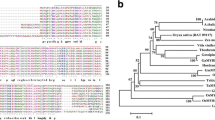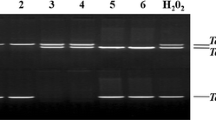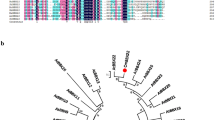Abstract
Knowledge on genes related to plant responses to adverse growth conditions and development is essential for germplasm improvement. In this study, a chrysanthemum R2R3-MYB transcription factor gene, designated CmMYB2 (GenBank accession No. JF795918), was cloned and functionally characterized. Expression of CmMYB2 in chrysanthemum leaves was up-regulated in response to drought, salinity and cold stress, as well as by treatment with exogenous abscisic acid (ABA). When the gene was constitutively expressed in Arabidopsis thaliana, it increased plant sensitivity to ABA and reduced stomatal aperture. Plant survival under drought was improved than in the wild type, as was the plants’ salinity tolerance. The level of expression of a number of genes associated with the stress response, including RD22, RD29A, RAB18, COR47, ABA1 and ABA2, was raised in the CmMYB2 transgenic Arabidopsis plants. CmMYB2 transgenic Arabidopsis plants were also delayed in flowering. The expression of CONSTANS (CO), FLOWERING LOCUS T (FT), SUPPRESSOR OF OVEREXPRESSION OF CONSTANS1 (SOC1), LEAFY (LFY) and APETALA1 (AP1) genes involved in flowering was down-regulated in the CmMYB2 transgenics. Together, these results suggest that CmMYB2 may be a promising gene for the drought and salt tolerance improvement and flowering-time modulation.







Similar content being viewed by others
References
Nakashima, K., Ito, Y., & Yamaguchi-Shinozaki, K. (2009). Transcriptional regulatory networks in response to abiotic stresses in Arabidopsis and grasses. Plant Physiology, 149, 88–95.
Shinozaki, K., & Yamaguchi-Shinozaki, K. (2007). Gene networks involved in drought stress response and tolerance. Journal of Experimental Botany, 58, 221–227.
Schwechheimer, C., Zourelidou, M., & Bevan, M. W. (1998). Plant transcription factor studies. Annual Review of Plant Physiology and Plant Molecular Biology, 49, 127–150.
Singh, K., Foley, R. C., & Onate-Sa′nchez, L. (2002). Transcription factors in plant defense and stress responses. Current Opinion in Plant Biology, 5, 430–436.
Rosinsky, J. A., & Atchley, W. R. (1998). Molecular evolution of the Myb family of transcription factors: Evidence for polyphyletic origin. Journal of Molecular Evolution, 46, 74–83.
Jin, H., & Martin, C. (1999). Multifunctionality and diversity within the plant MYB-gene family. Plant Molecular Biology, 41, 577–585.
Stracke, R., Werber, M., & Weisshaar, B. (2001). The R2R3-MYB gene family in Arabidopsis thaliana. Current Opinion in Plant Biology, 4, 447–456.
Kranz, H. D., Denekamp, M., Greco, R., Jin, H., Leyva, A., Meissner, R. C., et al. (1998). Towards functional characterisation of the numbers of the R2R3-MYB gene family from Arabidopsis thaliana. Plant Journal, 16, 263–276.
Tamagnone, L., Merida, A., Parr, A., Mackay, S., Culianez-Macia, F. A., Roberts, K., et al. (1998). The AmMYB308 and AmMYB330 transcription factors from antirrhinum regulate phenylpropanoid and lignin biosynthesis in transgenic tobacco. Plant Cell, 10, 135–154.
Gocal, G. F. W., Sheldon, C. C., Gubler, F., Moritz, T., Bagnall, D. J., MacMillan, C. P., et al. (2001). GAMYB-like genes, flowering, and gibberellin signaling in Arabidopsis. Plant Physiology, 127, 1682–1693.
Liu, L., Du, H., Tang, X. F., Wu, Y. M., Huang, Y. B., & Tang, Y. X. (2008). The roles of MYB transcription factors on plant defense responses and its molecular mechanism. Hereditas, 30, 1265–1271.
Payne, T., Clement, J., Arnold, D., & Lloyd, A. (1999). Heterologous myb genes distinct from GL1 enhance trichome production when overexpressed in Nicotiana tabacum. Development, 126, 671–682.
Schmitz, G., Tillmann, E., Carriero, F., Fiore, C., & Theres, K. (2002). The tomato Blind gene encodes a MYB transcription factor that controls the formation of lateral meristems. Proceedings of the National Academy of Sciences of the United States of America, 99, 1064–1069.
Urao, T., Yamaguchi-Shinozaki, K., Urao, S., & Shinozaki, K. (1993). An Arabidopsis myb homolog is induced by dehydration stress and its gene product binds to the conserved MYB recognition sequence. Plant Cell, 5, 1529–1539.
Abe, H., Urao, T., Ito, T., Seki, M., Shinozaki, K., & Yamaguchi-Shinozaki, K. (2003). Arabidopsis AtMYC2 (bHLH) and AtMYB2 (MYB) function as transcriptional activators in abscisic acid signaling. Plant Cell, 15, 63–78.
Ding, Z. H., Li, S. M., An, X. L., Liu, X., Qin, H. J., & Wang, D. W. (2009). Transgenic expression of MYB15 confers enhanced sensitivity to abscisic acid and improved drought tolerance in Arabidopsis thaliana. Journal of Genetics and Genomics, 36, 17–29.
Cominelli, E., Sala, T., Calvi, D., Gusmaroli, G., & Tonelli, C. (2008). Overexpression of the Arabidopsis AtMYB41 gene alters cell expansion and leaf surface permeability. Plant Journal, 53, 53–64.
Jung, C. K., Seo, J. S., Han, S. W., Koo, Y. J., Kim, C. H., Song, S. I., et al. (2008). Overexpression of AtMYB44 enhances stomatal closure to confer abiotic stress tolerance in transgenic Arabidopsis. Plant Physiology, 146, 623–635.
Cheong, Y. H., Chang, H. S., Gupta, R., Wang, X., Zhu, T., & Luan, S. (2002). Transcriptional profiling reveals novel interactions between wounding, pathogen, abiotic stress, and hormonal responses in Arabidopsis. Plant Physiology, 129, 661–677.
Fowler, S., & Thomashow, M. F. (2002). Arabidopsis transcriptome profiling indicates that multiple regulatory pathways are activated during cold acclimation in addition to the CBF cold response pathway. Plant Cell, 14, 1675–1690.
Kamei, A., Seki, M., Umezawa, T., Ishida, J., Satou, M., Akiyama, K., et al. (2005). Analysis of gene expression profiles in Arabidopsis salt overly sensitive mutants sos2–1 and sos3–1. Plant, Cell, and Environment, 28, 1267–1275.
Kuno, N., Moller, S. G., Shinomura, T., Xu, X. M., Chua, N. H., & Furuya, M. (2003). The novel MYB protein EARLY-PHYTOCHROME-RESPONSIVE1 is a component of a slave circadian oscillator in Arabidopsis. Plant Cell, 15, 2476–2488.
Wang, Z. Y., & Tobin, E. M. (1998). Constitutive expression of the CIRCADIAN CLOCK ASSOCIATED 1(CCA1) gene disrupts circadian rhythms and suppresses its own expression. Cell, 93, 1207–1217.
Chen, S. M., Miao, H. B., Chen, F. D., Jiang, B. B., Lu, J. G., & Fang, W. M. (2009). Analysis of expressed sequence tags (ESTs) collected from the inflorescence of Chrysanthemum. Plant Molecular Biology Reporter, 27, 503–510.
Murray, M. G., & Thompson, W. F. (1980). Rapid isolation of high molecular weight plant DNA. Nucleic Acids Research, 8, 4321–4326.
Thompson, J. D., Higgins, D. G., & Gibson, T. J. (1994). CLUSTAL W: Improving the sensibility of progressive multiple sequence alignment through sequence weighting, position-specific gap penalties and weight matrix choice. Nucleic Acids Research, 22, 4673–4680.
Otsuga, D., DeGuzman, B., Prigge, M. J., Drews, G. N., & Clark, S. E. (2001). REVOLUTA regulates meristem initiation at lateral positions. Plant Journal, 25, 223–236.
Livak, K. J., & Schmittgen, T. D. (2001). Analysis of relative gene expression data using real-time quantitative PCR and the 2-(Delta DeltaC(T)) method. Methods, 25, 402–408.
Clough, S. J., & Bent, A. F. (1998). Floral dip: A simplified method for Agrobacterium-mediated transformation of Arabidopsis thaliana. Plant Journal, 16, 735–743.
Pei, Z. M., Kuchitsu, K., Ward, J. M., Schwarz, M., & Schroeder, J. I. (1997). Differential abscisic acid regulation of guard cell slow anion channels in Arabidopsis wild-type and abi1 and abi2 mutants. Plant Cell, 9, 409–423.
Hugouvieux, V., Kwak, J. M., & Schroeder, J. I. (2001). A mRNA cap binding protein, ABH1, modulates early abscisic acid signal transduction in Arabidopsis. Cell, 106, 477–487.
Denekamp, M., & Smeekens, S. C. (2003). Integration of wounding and osmotic stress signals determines the expression of the AtMYB102 transcription factor gene. Plant Physiology, 132, 1415–1423.
Putterill, J., Laurie, R., & Macknight, R. (2004). It’s time to flower: The genetic control of flowering time. Bioessays, 26, 363–373.
Komeda, Y. (2004). Genetic regulation of time to flower in Arabidopsis thaliana. Annual Review of Plant Biology, 55, 521–535.
Boss, P. K., Bastow, R. M., Mylne, J. S., & Dean, C. (2004). Multiple pathways in the decision to flower: Enabling, promoting, and resetting. Plant Cell, 16(Suppl), S18–S31.
Hayama, R., & Coupland, G. (2003). Shedding light on the circadian clock and the photoperiodic control of flowering. Current Opinion in Plant Biology, 6, 13–19.
Hepworth, S. R., Valverde, F., Ravenscroft, D., Mouradov, A., & Coupland, G. (2002). Antagonistic regulation of flowering-time gene SOC1 by CONSTANS and FLC via separate promoter motifs. EMBO Journal, 21, 4327–4337.
Liljegren, S. J., Gustafson-Brown, C., Pinyopich, A., Ditta, G. S., & Yanofsky, M. F. (1999). Interactions among APETALA, LEAFY, and TERMINAL FLOWER1 specify meristem fate. Plant Cell, 11, 1007–1018.
Lee, J., Oh, M., Park, H., & Lee, I. (2008). SOC1 translocated to the nucleus by interaction with AGL24 directly regulates LEAFY. Plant Journal, 55, 832–843.
Blázquez, M. A., Soowal, L. N., Lee, I., & Weigel, D. (1997). LEAFY expression and flower initiation in Arabidopsis. Development, 124, 3835–3844.
Takeno, K., & Maeda, T. (1996). Abscisic acid both promotes and inhibits photoperiodic flowering of Pharbitis nil. Physiologia Plantarum, 98, 467–470.
Wang, W. Y., Chen, W. S., Chen, W. H., Hung, L. S., & Chang, P. S. (2001). Influence of abscisic acid on flowering in Phalaenopsis hybrid. Plant Physiology and Biochemistry, 40, 97–100.
Achard, P., Cheng, H., Grauwe, L. D., Grauwe, L. D., Decat, J., Schoutteten, H., et al. (2006). Integration of plant responses to environmentally activated phytohormonal signals. Science, 311, 91–94.
Villalobos, M. A., Bartels, D., & Iturriaga, G. (2004). Stress tolerance and glucose insensitive phenotypes in Arabidopsis overexpressing the CpMYB10 transcription factor gene. Plant Physiology, 135, 309–324.
Yamaguchi-Shinozaki, K., & Shinozaki, K. (2006). Transcriptional regulatory networks in cellular responses and tolerance to dehydration and cold stress. Annual Review of Plant Biology, 57, 781–803.
Finkelstein, R. R., Gampala, S. S. L., & Rock, C. D. (2002). Abscisic acid signaling in seeds and seedlings. Plant Cell, 14, S15–S45.
Sakuma, Y., Maruyama, K., Osakabe, Y., Qin, F., Seki, M., Shinozaki, K., et al. (2006). Functional analysis of an Arabidopsis transcription factor, DREB2A, involved in drought-responsive gene expression. Plant Cell, 18, 1292–1309.
Ito, Y., Katsura, K., Maruyama, K., Taji, T., Kobayashi, M., Seki, M., et al. (2006). Functional analysis of rice DREB1/CBF-type transcription factors involved in cold-responsive gene expression in transgenic rice. Plant and Cell Physiology, 47, 141–153.
Hu, H. H., You, J., Fang, Y. J., Zhu, X. Y., Qi, Z. Y., & Xiong, L. Z. (2008). Characterization of transcription factor gene SNAC2 conferring cold and salt tolerance in rice. Plant Molecular Biology, 67, 169–181.
Kang, J. Y., Choi, H. I., Im, M. Y., & Kim, S. Y. (2002). Arabidopsis basic leucine zipper proteins that mediate stress-responsive abscisic acid signaling. Plant Cell, 14, 343–357.
Liang, Y. K., Dubos, C., Dodd, I. C., Holroyd, G. H., Hetherington, A. M., & Campbell, M. M. (2005). AtMYB61, an R2R3-MYB transcription factor controlling stomatal aperture in Arabidopsis thaliana. Current Biology, 15, 1201–1206.
Schweighofer, A., Hirt, H., & Meskiene, I. (2004). Plant PP2C phosphatases: Emerging functions in stress signaling. Trends in Plant Science, 9, 236–243.
Gosti, F., Beaudoin, N., Serizet, C., Webb, A. A. R., Vartanian, N., & Giraudat, J. (1999). ABI1 protein phosphatase 2C is a negative regulator of abscisic acid signaling. Plant Cell, 11, 1897–1910.
Merlot, S., Gosti, F., Guerrier, D., Vavasseur, A., & Giraudat, J. (2001). The ABI1 and ABI2 protein phosphatases 2C act in a negative feedback regulatory loop of the abscisic acid pathway. Plant Journal, 25, 295–303.
Sáez, A., Apostolova, N., González-Guzmán, M., González-García, M. P., Nicolás, C., Lorenzo, O., et al. (2004). Gain-of-function and loss-of-function phenotypes of the protein phosphatase 2C HAB1 reveal its role as a negative regulator of abscisic acid signalling. Plant Journal, 37, 354–369.
Kuhn, J. M., Boisson-Dernier, A., Dizon, M. B., Maktabi, M. H., & Schroeder, J. I. (2006). The protein phosphatase AtPP2CA negatively regulates abscisic acid signal transduction in Arabidopsis, and effects of abh1 on AtPP2CA mRNA. Plant Physiology, 140, 127–139.
Sáez, A., Robert, N., Maktabi, M. H., Schroeder, J. I., Serrano, R., & Rodriguez, P. L. (2006). Enhancement of abscisic acid sensitivity and reduction of water consumption in Arabidopsis by combined inactivation of the protein phosphatase type 2C ABI1 and HAB1. Plant Physiology, 141, 1389–1399.
Leonhardt, N., Kwak, J. M., Robert, N., Waner, D., Leonhardt, G., & Schroeder, J. I. (2004). Microarray expression analyses of Arabidopsis guard cells and isolation of a recessive abscisic acid hypersensitive protein phosphatase 2C mutant. Plant Cell, 16, 596–615.
Chung, J. S., Zhu, J. K., Bressan, R. A., Hasegawa, P. M., & Shi, H. Z. (2008). Reactive oxygen species mediate Na+-induced SOS1mRNA stability in Arabidopsis. Plant Journal, 53, 554–565.
Lång, V., & Palva, E. T. (1992). The expression of a rab-related gene, rab18, is induced by abscisic acid during the cold acclimation process of Arabidopsis thaliana (L.) Heynh. Plant. Molecular Biology, 20, 951–962.
Albinsky, D., Masson, J. E., Bogucki, A., Afsar, K., Vass, I., Nagy, F., et al. (1999). Plant responses to genotoxic stress are linked to an ABA/salinity signaling pathway. Plant Journal, 17, 73–82.
Close, T. J. (1997). Dehydrins: a commonalty in the response of plants to dehydration and low temperature. Physiologia Plantarum, 100, 291–296.
Nylander, M., Svensson, J., Palva, E. T., & Welin, B. V. (2001). Stress-induced accumulation and tissue-specific localization of dehydrins in Arabidopsis thaliana. Plant Molecular Biology, 45, 263–279.
Shinozaki, K., & Yamaguchi-Shinozaki, K. (2000). Molecular responses to dehydration and low temperature: Differences and cross-talk between two stress signaling pathways. Current Opinion in Plant Biology, 3, 217–223.
Yamaguchi-Shinozaki, K., & Shinozaki, K. (1993). Characterization of the expression of a desiccation-responsive rd29 gene of Arabidopsis thaliana and analysis of its promoter in transgenic plants. Molecular and General Genetics, 236, 331–340.
Yamaguchi-Shinozaki, K., & Shinozaki, K. (1993). The plant hormone abscisic acid mediates the drought-induced expression but not the seed-specific expression of rd22, a gene responsive to dehydration stress in Arabidopsis thaliana. Molecular and General Genetics, 238, 17–25.
Shinozaki, K., & Yamaguchi-Shinozaki, K. (1997). Gene expression and signal transduction in water-stress response. Plant Physiology, 115, 327–334.
Zhu, J. K. (2002). Salt and drought stress signal transduction in plants. Annual Review of Plant Biology, 53, 247–273.
Acknowledgments
This work was supported by the National Natural Science Foundation of China (Grant No. 30872064, 31071820, 31071825), and the Program for New Century Excellent Talents in University of Chinese Ministry of Education (Grant No. NCET-10-0492), and the Fundamental Research Funds for the Central Universities (KYJ 200907, KYZ201112), the Program for Hi-Tech Research, Jiangsu, China, Grant (No. BE2010303), 948 Project of Ministry of Agriculture (Grant No. 2008-G3), by Qing Lan Project of Jiangsu Province (Grant No. 2008 [30]), and the Project Funded by the Priority Academic Program Development of Jiangsu Higher Education Institutions.
Author information
Authors and Affiliations
Corresponding author
Rights and permissions
About this article
Cite this article
Shan, H., Chen, S., Jiang, J. et al. Heterologous Expression of the Chrysanthemum R2R3-MYB Transcription Factor CmMYB2 Enhances Drought and Salinity Tolerance, Increases Hypersensitivity to ABA and Delays Flowering in Arabidopsis thaliana . Mol Biotechnol 51, 160–173 (2012). https://doi.org/10.1007/s12033-011-9451-1
Published:
Issue Date:
DOI: https://doi.org/10.1007/s12033-011-9451-1




